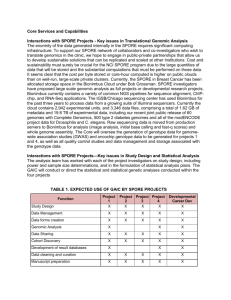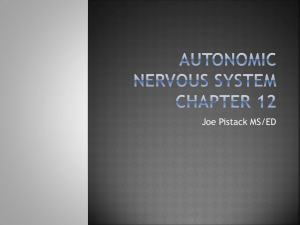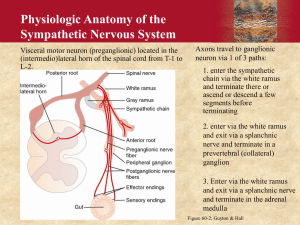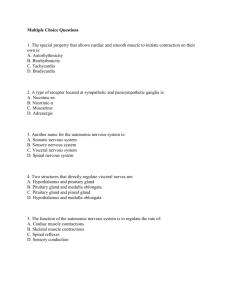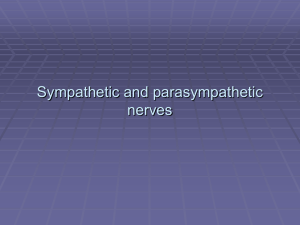Section: AP Biology
advertisement
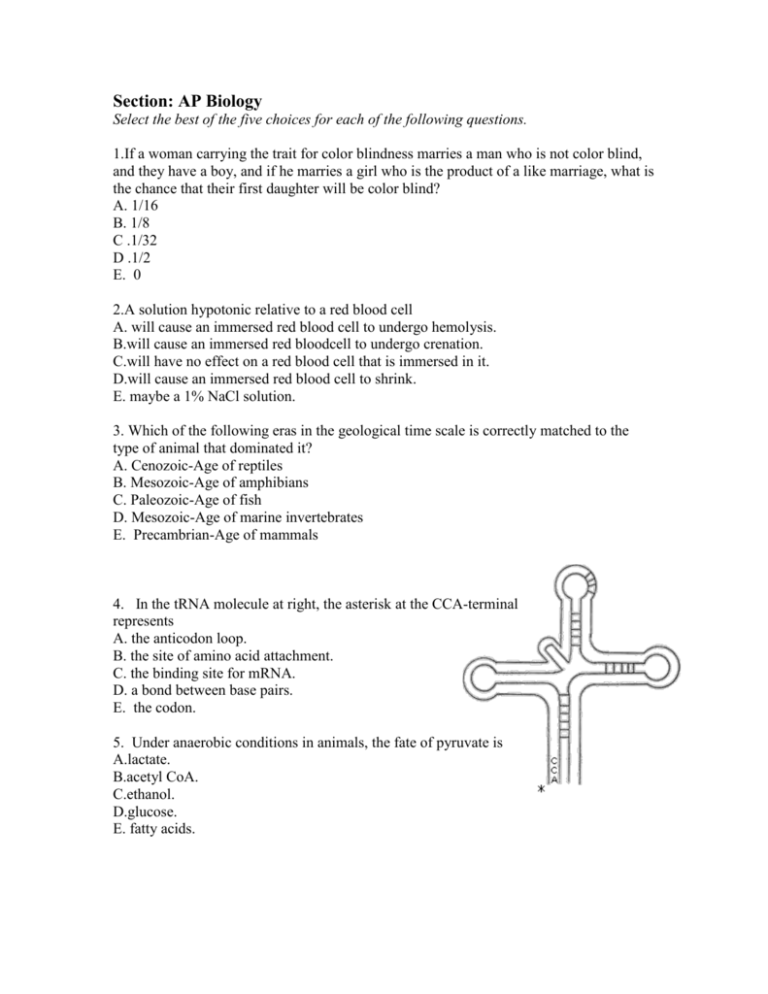
Section: AP Biology Select the best of the five choices for each of the following questions. 1.If a woman carrying the trait for color blindness marries a man who is not color blind, and they have a boy, and if he marries a girl who is the product of a like marriage, what is the chance that their first daughter will be color blind? A. 1/16 B. 1/8 C .1/32 D .1/2 E. 0 2.A solution hypotonic relative to a red blood cell A. will cause an immersed red blood cell to undergo hemolysis. B.will cause an immersed red bloodcell to undergo crenation. C.will have no effect on a red blood cell that is immersed in it. D.will cause an immersed red blood cell to shrink. E. maybe a 1% NaCl solution. 3. Which of the following eras in the geological time scale is correctly matched to the type of animal that dominated it? A. Cenozoic-Age of reptiles B. Mesozoic-Age of amphibians C. Paleozoic-Age of fish D. Mesozoic-Age of marine invertebrates E. Precambrian-Age of mammals 4. In the tRNA molecule at right, the asterisk at the CCA-terminal represents A. the anticodon loop. B. the site of amino acid attachment. C. the binding site for mRNA. D. a bond between base pairs. E. the codon. 5. Under anaerobic conditions in animals, the fate of pyruvate is A.lactate. B.acetyl CoA. C.ethanol. D.glucose. E. fatty acids. 6. Maple Syrup Urine disease is a disease in which the metabolism of the branchedchain amino acids is malfunctional. Knowing that this disease is an inborn error of metabolism, all of the following statements are logical conclusions EXCEPT A. The problem stems from increased levels of metabolites of branched chain amino acids in the plaama and urine. B. A critical enzyme in the degradation of these amino acids is absent. C. Omission of these amino acids from the diet may avert the effects of this disease. D. Omission of maple syrup from the diet may avert the effects of this disease. E. If untreated, the patient may die within the year. 7. Plot A depicts hemoglobin under normal conditions. Plot B shows that the curve has shifted to the right and down. This may occur under conditions of A. increased pH. B. decreased temperature. C. exercise. D. hyperventilation. E. breathing pure oxygen. 8. Plot B is a result of A. the Bohr effect. B. the altitude effect. C. the chloride shift. D. desaturation. E. saturation. 9. Which biome is correctly matched to its description? A. Grasslands are found in the southwestern U.S. B. A tropical rainforest has high humidity and much rainfall. The animal and plant life is sparse. C. Coniferous forest is synonymous with deciduous forest. D. The taiga is a treeless plain where the winters are severe. E. Shrublands have cool, wet winters and hot, dry summers. 10. A pyramid of biomass A.is a measure of the number of individuals in each trophic level. B.is a measure of the numbers of trophic levels. C.is a measure of the energy consumption at each trophic level. D.is a measure of the energy output of each trophic level. E. is a measure of the total weight of the organisms in each trophic level. 11. The bacterial cell wall is composed of A. chitin. B. peptidoglycan. C. cellulose. D. phospholipids. E. starch. 12. Which of the following statements is true? A. In prophase, the sister chromatids separate. B. In telophase, the nuclear membrane begins to form. C. In metaphase, the sister chromatids begin condensation. D. In anaphase, the chromosomes move to the spindle equator. E. In prophase, cytokinesis occurs. 13. Which of the following hormones will not cause a rise in plasma glucose concentration? A. glucagon B. cortisol C. epinephrine D. insulin E. adrenaline 14. Gastrulation results in three primary tissue layers that give rise to all the organs and tissues of the body. Which of the following statements is true? A. Endoderm gives rise to muscle. B. Epiderm gives rise to skin. C. Mesoderm gives rise to bone. D. Ectoderm gives rise to the gut lining. E. Periderm gives rise to skin. 15. The lens of the eye is formed by a process called A. morphogenesis. B. neurulation. C. gastrulation. D. embryonic induction. E. cleavage. 16. Which of the following statements is not true? A. Sebaceous glands secrete sweat. B. Pancreas secretes hormones, such as glucagon. C. Pancreas secretes digestive enzymes such as trypsin. D. Lacrimal gland secretes tears. E. Mammary glands secrete milk. 17. Which of the following molecules that are present in the nuclear medium would be bound by DNA polymerase if cytosine were on the opposite strand of DNA? A. CMP B. GMP C. dGTP D. ATP E. cAMP 18. A subject with Type A blood A. has A antibodies in his plasma. B. has B antigens on his red blood cells. C. can successfully receive blood from a type O person. D. can successfully receive blood from a type AB person. E. is Rh negative. 19. Industrial melanism refers to the process whereby A. light moths became dark moths. B. dark-colored moths became favored by the environment. C. a mutant gene for dark wings evolved. D. dark moths had a survival advantage on both light and dark tree trunks. E. skin cancer abounded due to industrial hazards. 20. Regarding the taxonomic classification of a human being, A. its phylum is Mammalia. B. its family is Hominidae. C. its genus name is sapiens. D. its kingdom is Chordata. E. its order is Vertebrata. 21. The types of mammals based on mechanism of embryological development and birth include A. the monotremes, which have pouches for development. B. the marsupials, which nourish their embryo via placentas. C. the placental mammals, such as the opossum. D. the monotremes, or egg-laying mammals. E. the mammaries, including the duck-billed platypus. 22. The only molecule not found in DNA is A. deoxyribose. B. uracil. C. cytosine. D. phosphate. E. thymine. 23. All of the following statements concerning sponges are true EXCEPT A. they are members of the phylum Porifera. B. their adult forms are sessile. C. they may have skeletons composed of spicules. D. they are predominantly freshwater species. E. they may have a skeleton composed of the protein spongin. 24. In the graph above, the arrow indicates specifically A. the biotic potential. B. the density-dependent effect. C. the sigmoid growth curve. D. the carrying capacity. E. the density-independent effect. 25. Which of the following conditions is due to the effects of a dominant allele? A. Albinism B. Hemophilia C. Sickle-cell anemia D. Polydactyly E. Color-blindness 26. Facilitated diffusion A. requires ATP. B. requires a protein carrier. C. refers to the osmosis of water. D. moves substances against a concentration gradient. E. is diffusion that occurs easily. 27. Examples of fungi include all of the following EXCEPT A. yeasts B. molds C. mildews D. mushrooms E. algae 28. In base pairing within DNA molecules, A. adenine is bound to thymine by hydrogen bonds. B. adenine forms a peptide bond with thymine. C. adenine bonds ionically to thymine. D. guanine binds to uracil. E. adenine binds to uracil. 29. All of the following statements concerning leaf anatomy are true EXCEPT A. The cuticle is composed of waxes and helps in water retention. B. The stomata are pores that allow gas diffusion. C. The mesophyll contains chloroplasts. D. The xylem conducts water. E. The palisade layer is adjacent to the lower epidermis. 30. Radial body symmetry is present in A. cnidarians. B. flatworms. C. arthropods. D. annelids. E. mollusks. 31. An example of a mechanism of post-mating reproductive isolation is A. mechanical isolation. B. hybrid sterility. C. seasonal isolation. D. behavioral isolation. E. geographical isolation. 32. What would the probable ratio of the number of brown-eyed children to the number of blue-eyed children be if their parents were both brown-eyed and both heterozygous for the allele for brown eyes? A. 3:1 B. 1:2:1 C. 1:3 D. 1:0 E. 1:1 33. Darwin's important observation pertaining to the birds of the Galapagos Islands was that A. there were many different finches, each with specially adapted wings for flight. B. there were many different finches on the islands, each with specially adapted beaks for feeding. C. all the finches on the various islands had the same beak and were of the same species. D. all the finches on the various islands had the same wing structure and were of the same species. E. the finches ate various different types of food, such as seeds, insects or fruit, and thus must be of different species. 34. One type of organic molecule that is not found in animal cell membranes is A.phospholipids. B.intrinsic proteins. C.extrinsic proteins. D.cellulose. E. cholesterol. 35. Punctuated equilibrium refers to which of the following? A. Short periods of rapid speciation separated by periods of slower evolutionary change B. Adaptive radiation C. Convergent evolution D. Gradualism E. Catastrophism 36. The pelagic province of the open ocean is divided into several different regions. The uppermost epipelagic region has more life than the deeper ones because A. it receives the fresh rainfall. B. light penetration allows for photosynthesis. C. light penetration allows for respiration. D. warmer temperatures allow for growth. E. tidal action keeps the nutrients suspended. 37. The replication fork A. is the site at which the single-stranded regions emerge. B. refers to the lagging strand. C. refers to the leading strand. D. refers to the site of base pair formation E. is seen in transcription. 38. Synapsis A. occurs during the second meiotic division. B. refers to the pairing between homologous chromosomes. C. is synonymous with chiasmata. D. refers to the tetrad of chromatids. E. are the junctions between neurons. 39. The cell types found in phloem are A. sieve tube members and vessels. B. sieve tube members and tracheids. C. tracheids and vessels. D. companion cells and vessels. E. sieve tube members and companion cells. 40. The cell organelles that are most similar to prokaryotes are A. the mitochondria and chloroplasts. B. the rough and smooth endoplasmic reticula. C. the rough endoplasmic reticula and ribosomes. D. the rough endoplasmic reticula and Golgi apparatuses. E. the lysosomes and ribosomes. 41. The notochord is the forerunner of which vertebrate structure? A. spinal cord B. vertebral column C. brain D. gill E. gill slits 42. Because fungi can obtain nutrients from nonliving organic matter, they are referred to as A. parasitic. B. saprophytic. C. eukaryotic. D. heterotrophic. E. pathogenic. 43. The founder effect A. is a direct effect of mutation. B. is an extreme case of gene flow. C. is an extreme case of genetic drift. D. occurs by natural selection. E. is an extreme case of natural selection. 44. The type of community interaction whereby one species benefits and the other is unaffected is specifically called A. symbiosis. B. mutualism. C. commensalism. D. predation. E. parasitism. 45. Which of the following is the female reproductive organ of a flower? A. stamen B. anther C. petal D. receptacle E. carpel 46. The anticodon is found on A. mRNA. B. rRNA. C. tRNA. D. DNA. E. ATP. 47. Gastrulation refers to A. fusion of the sperm and egg nuclei. B. embryonic cell division with no increase in embryo size. C. differentiation of body parts as signaled from an adjacent part. D. the development of the notochord and dorsal hollow nerve cord. E. the migrations of cells into three primary germ layers. 48. All of the following events occur in a flower EXCEPT: A. pollination. B. fertilization. C. megaspore formation. D. pollen tube growth. E. photosynthesis. 49. Double fertilization A. results in fraternal twins. B. results in identical twins. C. results in Siamese twins. D. is unique to angiosperms. E. occurs in all seed-producing vascular plants. 50. Decomposers feed on A. producers. B. herbivores. C. primary carnivores. D. consumers. E. dead organic matter. 51. The dark reactions of photosynthesis require all of the following EXCEPT A. glucose. B. ATP. C. NADPH. D. RuBP (ribulose bisphosphate). E. carbon dioxide. 52. Terms referring to the hydrologic (water) cycle include ALL of the following EXCEPT A. transpiration. B. evaporation. C. fixation. D. precipitation. E. runoff. 53. Mating between a blue-eyed woman and a heterozygous brown-eyed man would result in a ratio of brown-eyed to blue-eyed children of A. 1:1. B. 1:2. C. 2:1. D. 1:0. E. 0:1. 54. A phenotype refers to A. the genetic makeup of an individual. B. the expression of dominant traits. C. the expression of recessive traits. D. the manifest expression of the genotype. E. the heterozygous condition. 55. All of the plant groups below are vascular EXCEPT A. mosses. B. ferns. C. horsetails. D. gymnosperms. E. seed plants. 56. A bacteriophage A. is a bacterium that phagocytoses other organisms. B. is a bacterium that becomes phagocytosed by other organisms. C. is a virus that infects bacteria. D. is a fragment of DNA. E. lives in a lysogenic cell. 57. The reduced form of the coenzyme in the dehydrogenase enzymes is A. NADH. B. FAD. C. ADH. D. NAD+. E. ACTH. 58. In the first step of glycolysis, the phosphorylation of glucose is coupled to A. the production of carbon dioxide. B. the reduction of NAD+. C. the synthesis of ATP. D. the hydrolysis of ATP. E. the loss of electrons. 59. The active portion of the cytochrome enzymes is a heme group. It contains a mineral element that can exist in the oxidized or reduced state. This element is A. sodium. B. iodine. C. iron. D. potassium. E. calcium. 60. Miosmosis refers to the idea that an ion flowing down its electrochemical gradient drives ATP synthesis. This ion is A. phosphate ion, thus the term oxidative phosphorylation. B. sodium ion. C. iron ion. D. hydrogen ion. E. calcium ion. For questions 61 - 63, choose from the following terms, which describe the basic functional units of organs or systems. Each lettered choice may be used once, more than once, or not at all. (A) Nephron (D) Alveolus (B) Neuron (E) Villus (C) Sarcomere 61. The functional unit of the kidney, it produces urine. A. Nephron B. Neuron C. Sarcomere D. Alveolus E. Villus 62. As the functional unit of a muscle, it contracts. A. Nephron B. Neuron C. Sarcomere D. Alveolus E. Villus 63. This cell transmits messages. A. Nephron B. Neuron C. Sarcomere D. Alveolus E. Villus For questions 64 - 66, choose from the following terms, which refer to events dealing with DNA. Each lettered choice may be used once, more than once, or not at all. (A) Transcription (B) Translation (C) Transformation (D) Translocation (E) Transduction 64. The process by which a cell takes up DNA from its immediate environment and incorporates that DNA into its genome. A. Transcription B. Translation C. Transformation D. Translocation E. Transduction 65. The process of linking amino acids together to form a protein. A. Transcription B. Translation C. Transformation D. Translocation E. Transduction 66. The transfer of bacterial DNA from one organism to another by way of a viral vector, a bacteriophage. A. Transcription B. Translation C. Transformation D. Translocation E. Transduction For questions 67 - 70, choose from the following terms, which relate to the alternation of generations in plant life cycles. Each lettered choice may be used once, more than once, or not at all. (A) Sporophyte (D) Sporangia (B) Spore (E) Spore mother cell (C) Homosporous 67. Plant that produces only one type of spore. A. Sporophyte B. Spore C. Homosporous D. Sporangia E. Spore mother cell 68. The haploid product of a sporophyte. A. Sporophyte B. Spore C. Homosporous D. Sporangia E. Spore mother cell 69. The diploid generation, it becomes more dominant in the evolution of plants. A. Sporophyte B. Spore C. Homosporous D. Sporangia E. Spore mother cell 70. The multicellular structure that produces megaspores and microspores. A. Sporophyte B. Spore C. Homosporous D. Sporangia E. Spore mother cell For questions 71 - 74, choose from the following terms, which refer to animal cell organelles. Each lettered choice may be used once, more than once, or not at all. (A) Mitochondrion (B) Lysosome (C) Ribosome (D) Smooth endoplasmic reticulum (E) Microfilament 71. Functions in protein synthesis. A. Mitochondrion B. Lysosome C. Ribosome D. Smooth endoplasmic reticulum E. Microfilament 72. Functions in the cytoskeleton. A. Mitochondrion B. Lysosome C. Ribosome D. Smooth endoplasmic reticulum E. Microfilament 73. Fuses with phagocytic vesicles. A. Mitochondrion B. Lysosome C. Ribosome D. Smooth endoplasmic reticulum E. Microfilament 74. Synthesizes lipids. A. Mitochondrion B. Lysosome C. Ribosome D. Smooth endoplasmic reticulum E. Microfilament For questions 75 - 78, match the enzyme listed in each question with one of the following terms, which describe the key metabolic processes involved in complete glucose oxidation. Each lettered choice may be used once, more than once, or not at all. (A) Krebs Cycle (B) Electron transport chain (C) Glycolysis (D) Formation of acetyl CoA (E) Chemiosmosis 75. Hexokinase. A. Krebs Cycle B. Electron transport chain C. Glycolysis D. Formation of acetyl CoA E. Chemiosmosis 76. Cytochrome oxidase. A. Krebs Cycle B. Electron transport chain C. Glycolysis D. Formation of acetyl CoA E. Chemiosmosis 77. Pyruvate dehydrogenase. A. Krebs Cycle B. Electron transport chain C. Glycolysis D. Formation of acetyl CoA E. Chemiosmosis 78. Succinate dehydrogenase. A. Krebs Cycle B. Electron transport chain C. Glycolysis D. Formation of acetyl CoA E. Chemiosmosis For questions 79 - 81, choose from the following terms, which refer to plant hormones. Each lettered choice may be used once, more than once, or not at all. (A) Gibberellins (B) Abscisic acid (C) Ethylene (D) Auxins (E) Cytokinins 79. Stimulate(s) fruit ripening. A. Gibberellins B. Abscisic acid C. Ethylene D. Auxins E. Cytokinins 80. Promotes closure of the stomata. A. Gibberellins B. Abscisic acid C. Ethylene D. Auxins E. Cytokinins 81. Terminates seed dormancy. A. Gibberellins B. Abscisic acid C. Ethylene D. Auxins E. Cytokinins For questions 82 - 85, match the distinguishing characteristics described in each question with one of the following terms, which describe major animal phyla. Each lettered choice may be used once, more than once, or not at all. (A) Mollusca (D) Annelida (B) Chordata (E) Arthropoda (C) Echinodermata 82. Members of this phylum have dorsal body walls called mantles; each organism has a muscular organ called a foot. A. Mollusca B. Chordata C. Echinodermata D. Annelida E. Arthropoda 83. These segmented worms include the earthworms. A. Mollusca B. Chordata C. Echinodermata D. Annelida E. Arthropoda 84. Members of this phylum have hardened exoskeletons and jointed appendages. A. Mollusca B. Chordata C. Echinodermata D. Annelida E. Arthropoda 85. Locomotion in members of this phylum is based on a water-vascular system. A. Mollusca B. Chordata C. Echinodermata D. Annelida E. Arthropoda For questions 86 - 90, choose from the parts labeled A - E in the diagram below, which shows the secondary growth of a woody stem. Each lettered choice may be used once, more than once, or not at all. 86. Vascular cambium. A. Point A B. Point B C. Point C D. Point D E. Point E 87. Primary phloem. A. Point A B. Point B C. Point C D. Point D E. Point E 88. Primary xylem. A. Point A B. Point B C. Point C D. Point D E. Point E 89. Epidermis A. Point A B. Point B C. Point C D. Point D E. Point E 90. Cortex. A. Point A B. Point B C. Point C D. Point D E. Point E Questions 91-93 refer to the pedigree below. 91. With reference to the above figure, all of the following statements concerning the disease in question are true EXCEPT A. It is sex-linked. B. It is caused by a recessive gene. C. It may be hemophilia. D. It is passed from mothers to their sons. E. It is expressed only in the homozygous recessive state. 92. If the disease were colorblindness, the genotype of P1 must be A. XCXc. B. XCXC. C. XcXc. D. XCY. E. XcY. 93. If F2-5 were to marry a woman homozygous dominant for the trait in question, the probability that they would have a child afflicted with the disease is A. 0%. B. 25%. C. 50%. D. 100%. E. unknown; cannot be determined from information given. Questions 94 - 97 refer to the graph below, which represents data obtained from a spirometer, an instrument that measures the volume of air moved into and out of the lungs during breathing. The volume of air moved into the lungs during a normal quiet inspiration is called the tidal volume. This same volume will be moved out of the lungs during a normal quiet expiration. One tidal inspiration is labeled on the graph. 94. At the time of signal 1, the subject has inspired maximally. What is the subject's inspiratory reserve volume? A. 6500 ml B. 3500 ml C. 3000 ml D. 2500 ml E. 2000 ml 95. Just before signal two, the subject A. inspired maximally. B. expired forcefully. C. increased his or her breathing rate. D. decreased his or her breathing rate. E. stopped breathing. 96. What is the subject's vital capacity? A. 5500 ml B. 4500 ml C. 3500 ml D. 2500 ml E. 2000 ml 97. Assuming that the time span between signals two and three represents 30 seconds, this subject's respiratory rate is A. about 6 breaths per minute. B. about 24 breaths per minute. C. 12 breaths per 30 second interval. D. about 12 breaths per minute. E. none of the above. Questions 98 - 101 Suppose a teacher does a statistical analysis of the eye color in her school of mostly African-American students. She finds that of the 1000 students, 910 have brown eyes, while only 90 have blue eyes (considering green as blue, too). Five years later, she does her analysis again, since as an attempt at desegregation, some students are sent to other schools and new students from neighboring towns are brought in. She now finds that of the 1000 students, 840 have brown eyes and 160 have blue eyes. Her table below summarizes the data. Year 1981 1986 Brown Blue 910 90 840 160 Total 1000 1000 98. In the original sample (1981), the frequency of the allele for brown eyes (B) is A. 0.7. B. 0.49. C. 0.9. D. 0.3. E. 0.91. 99. The number of students in the original sample that are heterozygous for brown eyes is A. 910. B. 490. C. 420. D. 90. E. cannot be determined by the data given. 100. The deviation from the Hardy-Weinberg equilibrium, as exemplified by the new data in 1986, is due to A. mutation. B. migration. C. smaller sample size. D. selection. E. chance. 101. In the second sample, the frequency of the allele for blue eyes (b) is A. 0.84. B. 0.6. C. 0.04. D. 0.16. E. 0.4. Questions 102 - 105 refer to responses to receptor stimulation and blockade. The autonomic nervous system is the involuntary nervous system, which innervates smooth muscle, cardiac muscle and glands. There are two divisions in this system. The sympathetic division is stimulated by the release of the neurotransmitter chemical norepinephrine. Sympathetic stimulation causes the "fight or flight" reaction; it readies the body for action. It causes pupillary dilation, increases in heart and respiratory rates and vasoconstriction of many blood vessels to increase blood pressure. The parasympathetic division is stimulated by the release of the neurotransmitter acetylcholine. It allows the body to rest and recuperate, and as such, stimulates digestive activities. It has the opposite effect of the sympathetic division on the pupil, heart and many other organs. In the following experiment, a frog was used. A few drops of various chemicals were placed on appropriate organs or tissues in or on the frog and the responses were observed or measured. The responses listed below are all relative to the unstimulated state. Chemical: Atropine Response: pupil dilation Propranolol decreased heart rate Curare Paralysis of skeletal muscle 102. Given that atropine has no direct effect on the receptors for norepinephrine, the mechanism of action for atropine is A. stimulation of the sympathetic nervous system. B. inhibition of the sympathetic nervous system. C. stimulation of the parasympathetic nervous system. D. inhibition of the parasympathetic nervous system. E. not suggested by the information given. 103. Given that propranolol has no direct effect on the receptors for acetylcholine, it may be concluded that it A. stimulates norepinephrine releasing cells. B. blocks the action of norepinephrine. C. stimulates sympathetic nerves. D. stimulates parasympathetic nerves. E. inhibits parasympathetic nerve activity. 104. If one were to cut the parasympathetic nerve (vagus), which innervates the heart, one would expect to see A. an increase in heart rate, due to increased sympathetic activity. B. an increase in heart rate, due to decreased parasympathetic activity. C. a decrease in heart rate due to decreased parasympathetic activity. D. a dead heart, as a heart requires innervation for function. E. a decrease in heart rate, since that is the effect of parasympathetic stimulation. 105. Curare acts via A. stimulating sympathetic activity. B. stimulating parasympathetic activity. C. inhibiting parasympathetic activity. D. inhibiting sympathetic activity. E. none of the above. Questions 106 - 108 refer to the fates of pyruvate. Pyruvate is placed into three different chambers that contain various substances. It is then converted to the substances listed. Chamber: Product: A lactate B alcohol C CO2 and water 106. Which tube(s) lack(s) oxygen? A. A and B B. B and C C. A and C D. A, B, and C E. A only 107. Which tube(s) contain(s) yeast cells? A. A B. B C. C D. A and B E. A, B, and C 108. Which tube mimics the biochemical events that occur in the cells of a sprinter? A. A B. B C. C D. A and B E. B and C Questions 109 - 111 refer to the graphs below. Two species of Paramecium (A and B) are grown separately and together. The growth curves of their populations are depicted below. 109. The type of interaction between species A and B is described as A. mutualistic. B. protocooperative. C. competitive exclusion. D. a survivorship curve. E. symbiotic. 110. In the culture #3, the population size of species A when compared to its size in culture #1 A. is less than it is in culture #1. B. is the same as in culture #1, but takes longer to reach maximum size. C. is greater than it is in culture #1. D. is the same as it is in culture #1, but reaches maximum faster. E. is unaffected by the presence of species B. 111. When comparing the maximum population sizes for species B in the mixed culture vs. solo culture, it is evident that A. B reaches its maximum faster in the mixed culture. B. the maximum population size for B in the solo culture is twice that of B in the mixed culture. C. the maximum population size for B is reached fastest in the solo culture. D. in the solo cultures, B's population size surpasses that of A. E. B does not have a maximum population size in the mixed culture. Questions 112 - 113 refer to an experiment using glycerinated skeletal muscle. A rabbit psoas muscle is teased apart into individual fibers, some of which are maintained in glycerol solution under standard conditions at 25°C and pH 7. The length of the resting fibers is measured as 2 mm. Various solutions are added to the cerol solutions and the fibers are re-measured under the dissecting microscope. The results are listed in Table A. The solution in Experiment A that caused maximum contraction is then used in experiment B and experiment C, and the results are depicted in Tables B and C, respectively. Table A Standard Conditions (25°C, pH 7) Solution Glycerol Glycerol + ATP Glycerol + Salts KC1, MgCL2 Glycerol + ATP + Salts Length of Fiber (mm) 2 1.75 2 0.75 Table B Optimal solution from experiment A Conditions 25°C, pH 7 Length of Fiber (mm) .70 37°C, pH 7 Table C Optimal solution from experiment A Conditions 25°C, pH 7 Length of Fiber (mm) .65 25°C, pH 4 .50 1.00 112. In experiment A, contraction of skeletal muscle occurred most readily in the presence of A. glycerol. B. glycerol and ATP. C. glycerol and salts. D. glycerol, ATP, and salts. E. nervous stimulation. 113. Considering experiments B and C, skeletal muscle contraction is optimal under the conditions of A. standard conditions, by definition. B. room temperature and acidic environment. C. body temperature and neutral pH. D. freezing temperature and neutral pH. E. room temperature and neutral pH. Questions 114 - 115 refer to an experiment in polypeptide hydrolysis. Polypeptides are placed into warm watery solutions in separate beakers, each containing a different substance that has been isolated from pancreatic juice or intestinal tissue. After two hours, the contents of the individual beakers are analyzed. The results are below. Substance present in beaker: Results Mucus: polypeptides Trypsin: dipeptides; tripeptides Chymotrypsin: dipeptides; tripeptides Carboxypeptidase: amino acids; dipeptides; tripeptides Aminopeptidase: amino acids; dipeptides 114. It appears that the only substance that has no enzymatic activity is A. mucus. B. typsin. C. chymotrypsin. D. carboxypeptidase. E. aminopeptidase. 115. The only substances that act on the terminal residues of the polypeptide are A. carboxypeptidase and chymotrypsin. B. mucus and trypsin. C. trypsin and chymotrypsin. D. carboxypeptidase and aminopeptidase. E. polypeptides and aminopeptidase. Questions 116 - 117 refer to an experiment that concerns cell poisons. The cell is viewed with a powerful microscope under normal conditions and again in the presence of a cell poison. The activity of the cell is noted in the chart below. Poison Cell Activity None Normal Cytochalasin B No movement of vesicles and other organelles. No contraction in skeletal muscle fibers. Colchicine No chromosome movement. 116. The organelles that cytochalasin B must act on are A. actin and myosin. B. microtubules. C. microfilaments. D. mitochondria. E. the nucleus. 117. The protein that colchicine binds to is A. actin. B. myosin. C. tubulin. D. histone. E. chromatin. Questions 118 - 120 refer to the table below, in which the presence (+) or absence (-) of certain types of organelles in five sample human cells is indicated. A blank does not signify the absence of an organelle, just its relative lack of importance when compared to the importance of other organelles. Nucleus Flagellum Lysosome Mitochondria Golgi Apparatus Cell A - - - Cell B + - + ++ Cell C + + + + Cell D + - ++ Cell E + - + 118. Which cell is most likely to be one that is secreting proteins? A. Cell A B. Cell B C. Cell C D. Cell D E. Cell E 119. Which cells would most likely be found in blood? A. A and B B. B and E C. A and D D. D and E E. C and D 120. Cell C is A. a muscle cell, due to the presence of mitochondria. B. an egg cell. C. a neuron. + D. prokaryotic. E. haploid. Answers 1. A 2. A 3. C 4. B 5. A 6. D 7. C 8. A 9. E 10. E 11. B 12. B 13. D 14. C 15. D 16. A 17. C 18. C 19. B 20. B 21. D 22. B 23. D 24. D 25. D 26. B 27. E 28. A 29. E 30. A 31. B 32. A 33. B 34. D 35. A 36. B 37. A 38. B 39. E 40. A 41. B 42. B 43. 44. 45. 46. 47. 48. 49. 50. 51. 52. 53. 54. 55. 56. 57. 58. 59. 60. 61. 62. 63. 64. 65. 66. 67. 68. 69. 70. 71. 72. 73. 74. 75. 76. 77. 78. 79. 80. 81. 82. 83. 84. C C E C E E D E A C A D A C A D C D A C B C B E C B A D C E B D C B D A C B A A D E 85. 86. 87. 88. 89. 90. 91. 92. 93. 94. 95. 96. 97. 98. 99. 100. 101. 102. 103. 104. 105. 106. 107. 108. 109. 110. 111. 112. 113. 114. 115. 116. 117. 118. 119. 120. C D C E A B E D A C B B E A C B E D B B E A B A C B A D C A D C C E C E

